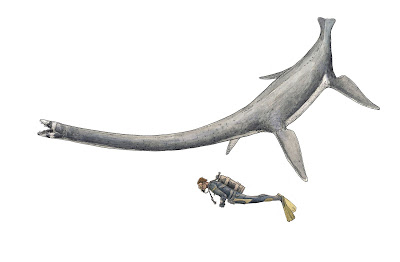Together they form some of the oldest (and last remaining) wonders of the ancient world. The great pyramids of Giza, with their smooth exteriors carved from fine grain white limestone quarried at Tura on the Giza-plateau, are built from stone that speaks of Egypt's much older geologic history.
The limestone from Tura was the finest and whitest of all the Egyptian quarries and chosen for the facing stones for the richest tombs. It is interesting in that it is made up almost entirely of Nummulites, a lovely single-celled organism. Nummulites (Lamarck, 1801) are the calcareous chambered shells (tests) of extinct forms of marine, amoeba-like organisms — protozoans or protists — called foraminifera that accumulated in huge quantities during the early Cenozoic. They look very much like little white, round crackers or cross-sections of plants with their concentric rings.
Imagine millions of them with their wee calcium carbonate skeletons living, dying and sinking to the seafloor. Over time, these little lovelies gathered in layers, pressure and time doing the rest. They became cemented together and helped form some of the most beautiful limestones we have today. It is remarkable to think that Khufu or Cheops, the Great Pyramid of Egypt, the oldest and largest of the pyramids at Giza built back in the 4th dynasty golden age and the only remaining wonder of the ancient world, is made up of teeny, tiny single-celled fossils — mindblowing!
They are commonly found as fossils in Eocene to Miocene marine rocks, particularly around southwest Asia and the Mediterranean — including the Eocene limestones of Egypt that lived in the Tethys sea.
 |
| Fossil Nummulites / Urbasa, Navarre |
The small size of most cells has to do with how they move the nutrients they need across their cell membrane — a process called diffusion. Nummulites grew much larger, six inches is mighty big for a single-celled organism, because of their overall design. They evolved to increase their surface area and create a greater opportunity for diffusion. Clever.
In our modern Nummulites, we see a symbiotic relationship with algae that allowed them to grow much larger. Each of these little fellows has a community of them living with him. Lorraine Casazza, a University of California at Berkeley paleontologist did some great work on the nummulites from Egypt.
For the central chamber, with the sarcophagus of the pharaoh, lovely reddish-pink granite from Aswan was used. The granite helped to take the weight of this massive construction. The ancient Egyptians also used nummulite shells as coins. It is not surprising then that the name "Nummulites" is a diminutive form of the Latin nummulus meaning "little coin," a direct reference to their shape and usage.
 |
| A Nummulite Protozoan Foraminiferan |
The papyrus is addressed to Ankh-haf, Khufu’s half-brother, and describes the undertaking of an expedition by a 200-man crew to the limestone quarries near Tura, on the eastern shore of the Nile. After loading the blocks onto their ship, the expedition indented to float down the river Nile for a successful delivery. They were then joined by another 100,000 slaves who had the unenviable task of unloading the 2-3 ton blocks of limestone built from nummulites, then pulling them across ramps to be dragged to the construction site.
It is amazing to have documentation from the 4th dynasty and poetic that this shipping order should be for materials, immortalized first as nummulites in the Eocene, excavated, carved and immortalized at Giza.
 |
| Herodotus' Histories, Book VIII |
In his literary work Historiae, Book II, chapter 124–126, Herodotus writes: "As long as Rhámpsinîtos was king, as they told me, there was nothing but orderly rule in Egypt, and the land prospered greatly. But after him Khéops became king over them and brought them to every kind of suffering: He closed all the temples; after this he kept the priests from sacrificing there and then he forced all the Egyptians to work for him.
So some were ordered to draw stones from the stone quarries in the Arabian mountains to the Nile, and others he forced to receive the stones after they had been carried over the river in boats, and to draw them to those called the Libyan mountains. And they worked by 100,000 men at a time, for each three months continually. Of this oppression there passed ten years while the causeway was made by which they drew the stones, which causeway they built, and it is a work not much less, as it appears to me, than the pyramid.
For the length of it is 5 furlongs and the breadth 10 fathoms and the height, where it is highest, 8 fathoms, and it is made of polished stone and with figures carved upon it. For this, they said, 10 years were spent, and for the underground chambers on the hill upon which the pyramids stand, which he caused to be made as sepulchral chambers for himself in an island, having conducted thither a channel from the Nile."
It is estimated that 5.5 million tonnes of nummulites limestone, 8,000 tonnes of granite (imported from Aswan), and 500,000 tonnes of mortar were used in the construction of the Great Pyramid. Built by an evil genius, yes, but stunning none-the-less. Unintentionally, it may have been one of the largest — and arguably cruellest — paleontological excavations ever attempted.
Photo of Fossil nummulites in Urbasa, Navarre by Theklan - Own work, CC BY-SA 2.5, https://commons.wikimedia.org/w/index.php?curid=1125411
Photo: Nummulites from above and horizontally bisected by R A Lydekker - Life and Rocks, Public Domain, https://commons.wikimedia.org/w/index.php?curid=3048471
Photo: Fragment from Herodotus' Histories, Book VIII on Papyrus Oxyrhynchus 2099, Early 2nd Century AD. Papyrology Rooms, Sackler Library, Oxford
References: Nummulite', Tiscali Dictionary of Animals, retrieved 17 August 2004
Hottinger, Lukas (2006-09-08). "Illustrated Glossary of terms used in foraminiferal research". Paleopolis. Retrieved 2018-11-11.
Reference: Lorraine Casazza, UCMP: https://ucmp.berkeley.edu/science/fieldnotes/casazza_0711.php
Fancy a visit to Cheops? Visit: 29°58′45″N 31°08′03″E


































